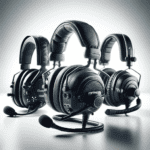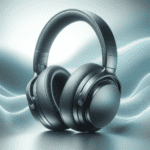Introduction to Aviation Headsets
Importance of communication and hearing protection in aviation
Aviation is an industry where effective communication and clear audio transmission are crucial for safety and efficiency. Pilots, air traffic controllers, and ground crew members rely on seamless communication to coordinate takeoffs, landings, and all the intricate details that ensure smooth operations in the sky. In this high-stakes environment, any miscommunication or misunderstanding can have dire consequences.
That’s why aviation headsets play a pivotal role in facilitating crystal-clear communication among aviation professionals. Moreover, hearing protection is paramount in aviation due to the significant noise levels experienced during flights.
The noise produced by aircraft engines, wind resistance, and cabin pressure can reach hazardous levels that may harm pilots’ hearing over time. To safeguard against such risks, aviation headsets are designed not only to offer reliable communication but also to provide effective noise reduction capabilities.
Evolution of aviation headsets over the years

The history of aviation headsets stretches back to the early days of flight when pilots used basic ear cups with rudimentary microphones attached. These early iterations were predominantly meant for voice amplification rather than noise reduction.
As aviation technology advanced through the 20th century with increased aircraft engine power and speeds, it became evident that more sophisticated headset designs were necessary. In response to these demands, aviation headsets gradually evolved from simple voice amplifiers into sophisticated pieces of equipment encompassing state-of-the-art technologies.
Over time, manufacturers introduced active noise cancellation (ANC) systems that employ advanced algorithms to counteract ambient noise levels actively. This technology revolutionized the way pilots experienced sound within the cockpit by significantly reducing both engine roar and external noises.
Additionally, improvements in ergonomic design have enhanced comfort for pilots during long flights or extended periods spent wearing headsets. Modern aviation headsets now feature adjustable headbands and cushioned ear seals, ensuring a snug fit while alleviating pressure points.
The integration of Bluetooth connectivity and wireless capabilities has further elevated the convenience and functionality of aviation headsets, allowing for seamless integration with various devices and communication systems. Aviation headsets have evolved from basic voice amplifiers to advanced communication tools equipped with noise reduction capabilities.
These cutting-edge headsets provide clear audio transmission while simultaneously protecting pilots’ hearing from the excessive noise levels experienced during flights. The continuous advancements in technology and ergonomic design have undoubtedly revolutionized the way aviation professionals communicate and stay protected in their critical work environment.
Factors to Consider When Choosing an Aviation Headset
Noise Reduction Capabilities
Aviation environments are notoriously noisy, with the constant roar of engines and wind noise. Therefore, one of the most critical factors to consider when selecting an aviation headset is its noise reduction capabilities. There are two primary methods that headsets employ to combat this issue: active noise cancellation (ANC) technology and passive noise reduction features.
Active Noise Cancellation Technology: ANC technology actively reduces unwanted external sounds by using microphones to detect ambient noise and then generating opposing sound waves. These opposing sound waves cancel out the incoming noises before they reach your ears.
This advanced technology is exceptionally effective in eliminating low-frequency sounds, such as engine rumble or wind turbulence, providing a peaceful listening environment for pilots. Passive Noise Reduction Features: In addition to ANC, aviation headsets often incorporate several passive noise reduction features.
These include specially designed ear cups that create a seal around your ears, preventing sound leakage and reducing ambient noise intrusion. Furthermore, headsets may include extra padding or cushioning materials in the ear seals to enhance comfort and provide additional passive noise reduction.
Comfort and Fit

When spending long hours in the cockpit, comfort is paramount for pilots. A well-fitted headset can significantly reduce fatigue and discomfort during extended flights. Therefore, it is crucial to consider comfort and fit when choosing an aviation headset.
Adjustable Headbands and Ear Cups: Look for headsets that offer adjustable headbands so you can find the perfect fit for your specific head shape and size. The ability to adjust the tension in the headband ensures a secure yet comfortable fit throughout your flight.
Similarly, adjustable ear cups allow you to position them precisely over your ears for optimal comfort while maintaining an effective seal against external noises. Cushioned Ear Seals for Extended Use: Aviation headsets often feature soft, cushioned ear seals that help distribute pressure evenly around the ears.
This padding not only enhances comfort but also aids in passive noise reduction by creating a seal against ambient sounds. Look for headsets with replaceable ear seals, as they can wear out over time and may need replacing to maintain optimal comfort and performance.
Audio Quality and Clarity
In aviation, clear communication is vital for safety and effective collaboration between pilots and air traffic control. Therefore, consider audio quality and clarity when selecting an aviation headset. High-Fidelity Speakers for Accurate Sound Reproduction: The quality of speakers within an aviation headset significantly impacts how accurately you hear important audio cues such as radio communications or warning signals.
Look for headsets that incorporate high-fidelity speakers capable of reproducing a broad range of frequencies with clarity. This ensures that you can distinguish even subtle audio details without distortion or degradation.
Noise-Canceling Microphones for Clear Communication: Equally important is the microphone’s performance in an aviation headset. Noise-canceling microphones are designed to minimize ambient noise interference during transmissions, ensuring clear communication with air traffic control or fellow crew members.
These microphones use advanced technology to reduce background noise while enhancing your voice’s clarity, making your transmissions crisp and easy to understand even in noisy cockpit environments. By considering these factors – noise reduction capabilities, comfort and fit, as well as audio quality and clarity – you can make an informed decision when selecting the best aviation headset suited to your needs, ensuring a comfortable flight experience while maintaining effective communication throughout your journey.
Top Aviation Headsets on the Market Today
Bose A20 Aviation Headset
The Bose A20 Aviation Headset is a true testament to engineering excellence, setting a benchmark for aviation headsets. Its active noise cancellation technology, equipped with customizable levels, allows pilots to create their own sanctuary in the cockpit. The headset’s sophisticated algorithms constantly analyze ambient noise and generate an equal but opposite sound wave to cancel out unwanted sounds, resulting in a serene and focused environment.
Weighing in at just 12 ounces, the Bose A20 is incredibly lightweight, ensuring minimal fatigue during long flights. Its comfortable ear seals provide an excellent acoustic seal while maintaining breathability for optimal comfort.
Pilots can enjoy extended periods of use without discomfort or irritation. Furthermore, the Bose A20 features Bluetooth connectivity that seamlessly integrates with other devices.
This enables pilots to effortlessly connect their headset to smartphones or tablets for audio streaming or communication purposes. The intuitive control module allows for easy adjustment of volume and audio sources on the go.
Lightspeed Zulu 3 Aviation Headset
The Lightspeed Zulu 3 Aviation Headset places paramount importance on providing advanced active noise reduction (ANR) technology with adjustable levels. This feature ensures that pilots can customize their level of noise cancellation according to their specific needs and preferences.
Designed with pilot comfort as a top priority, the Zulu 3 boasts plush ear cushions that envelop the ears while effectively sealing out external noises. The stainless-steel headband provides durability and stability without sacrificing flexibility.
With this secure fit, pilots can experience hours of uninterrupted comfort even during long cross-country flights. Moreover, the Lightspeed Zulu 3 offers both wired and wireless connectivity options.
Pilots can connect via a standard 3.5mm audio cable or utilize the integrated Bluetooth technology for seamless wireless connectivity with compatible devices. This versatility allows for ultimate convenience and adaptability in various cockpit setups.
David Clark ONE-X ANR Aviation Headset
The David Clark ONE-X ANR Aviation Headset sets itself apart with its hybrid electronic noise cancellation system. By combining active noise reduction technology with passive noise attenuation, this headset provides an unparalleled level of quietude even in the noisiest environments.
In terms of comfort, the ONE-X features soft, breathable leatherette ear seals that ensure maximum comfort while maintaining effective noise isolation. These seals conform to the shape of each individual’s ears, sealing out external noises and enhancing audio clarity.
A standout feature of the David Clark ONE-X is its dual volume controls, allowing pilots to independently adjust the audio levels for each earcup. This level of customization ensures optimal sound balance tailored to individual preferences, ensuring a personalized and immersive listening experience during flights.
Specialty Aviation Headsets
Helicopter-specific headsets
Flying a helicopter presents unique challenges in terms of noise and wind interference. Helicopter-specific headsets are designed to address these issues and provide pilots with the optimal communication and hearing experience.
One key feature of these headsets is enhanced noise reduction, which helps combat the high levels of rotorcraft noise typically experienced in helicopters. The ear cups are specially designed to block out the low-frequency sounds generated by the rotor blades, allowing pilots to focus on clear communication without being overwhelmed by background noise.
Another crucial aspect of helicopter-specific headsets is the boom microphone, which is specifically engineered to reduce wind interference. Helicopters generate significant air movement around the cockpit due to their design, and this can cause unwanted turbulence near microphones during communication.
The boom microphone effectively minimizes wind noise, ensuring clear transmission and making it easier for pilots to communicate with air traffic control or other crew members. With these specialized features, helicopter-specific headsets contribute to safer and more efficient flight operations.
Military-grade aviation headsets
Military aviation demands robust equipment that can withstand harsh environments while providing reliable communication capabilities. Military-grade aviation headsets are designed for durability and performance under challenging circumstances. These headsets are built with rugged construction materials that can endure rough handling, extreme temperatures, moisture, and vibrations often encountered in military operations.
In addition to their durability, military-grade aviation headsets offer integrated radio communication capabilities. This means that pilots can seamlessly communicate over multiple channels without needing separate devices or equipment.
This feature enhances efficiency during missions by allowing real-time coordination among team members while maintaining a high level of situational awareness. Whether it’s maneuvering through rugged terrains or undertaking complex tactical missions, military-grade aviation headsets provide reliable audio transmission, durable build quality, and advanced features tailored for military professionals operating in demanding environments.
Conclusion
Aviation headsets play a vital role in ensuring effective communication and hearing protection for pilots. With advancements in technology, manufacturers have developed a wide range of headsets that cater to different needs and specialties within the aviation industry. From the helicopter-specific headsets that combat rotorcraft noise and wind interference to military-grade headsets designed for durability and integrated radio communication, there is a headset available for every scenario.
By carefully considering factors such as noise reduction capabilities, comfort and fit, and audio quality, pilots can select the best aviation headset that meets their specific requirements. These headsets not only enhance safety by providing clear communication but also prioritize pilot comfort during long flights.
Investing in a high-quality aviation headset is an investment in both professional performance and personal well-being. With the right headset by their side, pilots can soar through the skies with confidence, knowing they have reliable communication tools that allow them to focus on what matters most – flying safely and efficiently.









